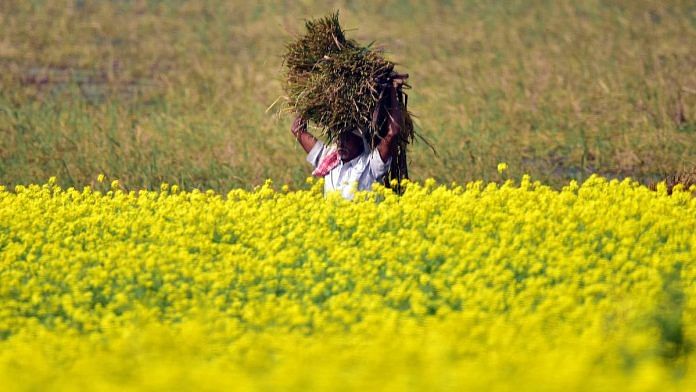New Delhi: The Solvent Extractors’ Association of India (SEA), India’s premier association of vegetable oil processors, has urged the central government to divert the area under wheat and paddy crop in Punjab and Haryana to cultivation of oilseeds. According to the SEA, this can increase the production of edible oil in the country by 25 lakh tonnes.
The suggestion was made in the SEA’s “pre-Budget memorandum for vegetable oils and oilseed sector for 2022-23”, which was handed over to Finance Minister Nirmala Sitharaman last week. The document, accessed by ThePrint, pointed out the need to divert some land in Punjab and Haryana from wheat and paddy production to soya, sunflower and maize production in the kharif season and rapeseed cultivation in rabi season.
India is the world’s biggest importer of edible oils, but imports have fallen in the last two years owing to the Covid outbreak. This year’s imports have been the lowest in six years.
According to the memorandum, in the past two decades, edible oil dependence on imports which was only three per cent in the 1990s, has risen to approximately 70 per cent. The main reason behind this is stagnant oilseed production — around 2.8-3 crore tonnes, with productivity at 900-1,000 kg/hectare.
Also read: Govt’s plan to tackle edible oil price rise: Push for domestic rice bran oil production
‘MSP-driven wheat and rice production created imbalance’
An estimate made by the SEA said around 60 lakh hectares of land is under wheat cultivation in Punjab and Haryana. If 50 per cent of this is incentivised to shift towards mustard farming in the next two-three years, the production of rapeseed/mustard would go up by 60 lakh tonnes, resulting in 25 lakh tonnes more of edible oil production in the country, it claimed.
The minimum support price (MSP)-driven production of wheat and paddy in Punjab and Haryana has created huge anomalies and imbalance by way of oversupply, when compared to the available demand, the SEA stated. It further noted that these “mountains” of wheat and rice are challenging the country’s storage infrastructure.
“Rapeseed and mustard are rabi crops and encouraging them would mean lower wheat acreage. It is a win-win situation, lower supply of wheat and a larger supply of high oil-bearing mustard. This would help to curtain the depleting ground-water and straw burning,” B.V. Mehta, executive director of the SEA, told ThePrint.
Other methods suggested
The association has also made other suggestions to boost the production of vegetable oil in the country, such as incentivising the production and introduction of genetically modified oilseed crops.
One of the main recommendations is the introduction of genetically modified (GM) oilseed crops in the country. According to the memorandum, this can raise productivity by 15 to 20 per cent. It also advocated for the release of indigenously developed GM Mustard at the earliest, citing the modified BT Cotton as a “shining example” of a leap in cottonseed oil production in our country.
The SEA suggested introduction of various incentives such as grants, subsidies, technological upgradation in a bid to create an economic climate for exploring the full potential of various non-traditional sources of edible oils such as rice bran oil, cottonseed oil, maize oil and others.
The association claimed that these minor oils could add almost 10 lakh tonnes to the edible oil pool in the next five years, if the current rice bran oil production of 10 lakh tonnes could be increased by three lakh tonnes and a similar boost be given to the production of cottonseed oil.
The edible oil association, while congratulating the government for the recently announced, National Mission on Edible Oils-Oil Palm — which proposes to cover an additional area of 6.5 lakh hectares (lha) under oil palm cultivation by 2025-26, and another 6.7 lha by 2029-30 — sought the inclusion of mustard, groundnut, soybean in the scheme with an allocation of at least Rs 5,000 crore per annum.
(Edited by Poulomi Banerjee)
Also read: Forget petrol & diesel, prices of edible oils have soared even higher in June, July



